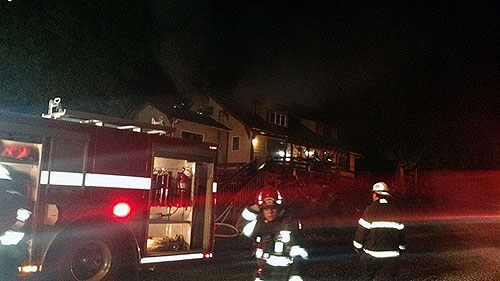
Chimney Fire: No injuries reportedWhen to Clean a Chimney Flue
December 18, 2015
According to information made public by the Ketchikan Fire Department, smoke alarms woke the resident and the occupant and pet made it safely out of the house.
Photo courtesy Ketchikan Fire Department
Mike Bellanich, owner of Southeast Services in Ketchikan, recommends that if you burn wood that you check and clean your chimney regularly. If you are a frequent wood burner, Bellanich recommends having your chimney cleaned at least every six months and as frequently as needed. Southeast Services offers chimney cleaning among the many services offered in the Ketchikan area. To aid in the prevention of chimney fires and carbon monoxide intrusion and to help keep wood stoves and fireplaces functioning properly, the Chimney Safety Institute of America (CSIA) offers the following safety tips: 1. Get an annual chimney check. Have chimneys inspected annually, and cleaned as necessary, by a qualified professional chimney service technician. This reduces the risk of fires and carbon monoxide poisonings due to creosote buildup or obstructions in the chimneys. 2. Keep it clear. Keep tree branches and leaves at least 15 feet away from the top of the chimney. 3. Install a chimney cap to keep debris and animals out of the chimney. 4. Choose the right fuel. For burning firewood in wood stoves or fireplaces, choose well seasoned wood that has been split for a minimum of six months – one year and stored in a covered and elevated location. Never burn Christmas trees or treated wood in your fireplace or wood stove. 5. Build it right. Place firewood or fire logs at the rear of the fireplace on a supporting grate for a fireplace. To start the fire, use kindling or a commercial firelighter. Never use flammable liquids. 6. Keep the hearth area clear. Combustible material too close to the fireplace, or to a wood stove, could easily catch fire. Keep furniture at least 36 inches away from the hearth. 7. Use a fireplace screen. Use metal mesh or a screen in front of a fireplace to catch flying sparks that could ignite or burn holes in the carpet or flooring. 8. Install smoke and carbon monoxide detectors. Place detectors throughout the house and check batteries in the spring and fall. When you change your clocks for Daylight Savings Time, remember to check your batteries. 9. Never leave a fireplace fire unattended. Before turning in for the evening, be sure that the fire is fully extinguished. Supervise children and pets closely around wood stoves and fireplaces. 10. The CSIA recommends annual inspections. The National Fire Protection Association also recommends that all chimneys are inspected on an annual basis. However, chimneys should be inspected and cleaned as frequently as needed.
Edited by Mary Kauffman, SitNews
Source of News & Photos:
|
||
